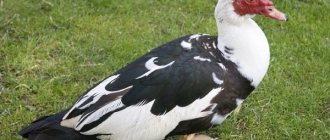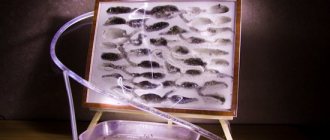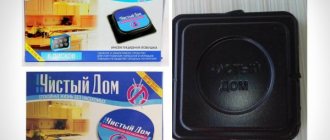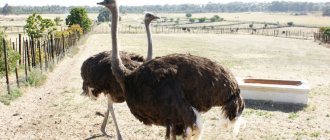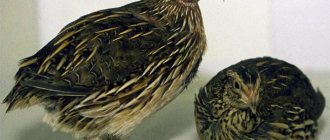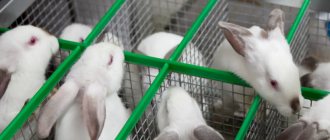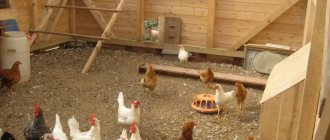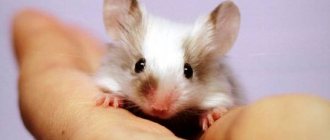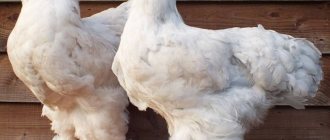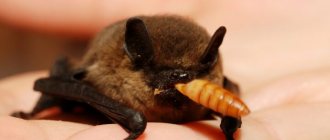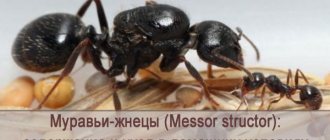Flight
Although adult males are known to rarely fly, they have fully developed wings and pigmented muscles typical of cockroaches, capable of meeting the high-speed energy needs of long-duration flight. In laboratory tests from a 2.5 m high ramp, adult males were able to align dorsoventrally and rapidly spread their wings to control and manipulate gliding; however, active flight did not maintain or increase altitude. Adult females have only vestigial wings and lack the muscles needed for flight, and have shown no flight control in test runs.
Differences between a male and a female
Male and female marbled cockroaches differ in body size. The wings of males are shorter, the back of the body is pointed. Before mating, they actively flap their wings. In the male, the upper side of the abdomen is almost black, in the female it is lighter.
In addition, you can determine that this is a female by the ooteca that she wears on herself.
Conditions of detention
The ideal temperature is at the upper end of the range 24–35°C. They will not reproduce at temperatures below 20°C. If the humidity is too low there will be problems with shedding. Can tolerate lower humidity than many other cockroach species. This type of cockroach will also accumulate more water in its body if it feeds well on fruits, and water will be released during times of stress.
When keeping, humidity is not as important as a supply of food with a high moisture content, which allows you to avoid spraying the terrarium, as other types of tropical insects need. The terrarium should be kept clean and dry to ensure that excrement is dry and does not provide a breeding ground for bacteria or fungi. Vertically stacked egg trays and good ventilation help a lot with this.
Mealworm, or Great mealworm (lat. Tenebrio molitor)
Due to the ease of breeding, they were the very first to appear to me. Collecting information was not difficult, and at first the worms settled in a simple container. The result was not bad: even in relatively spartan conditions, they multiplied stably.
But over time, some rules for their more productive maintenance appeared: The container must be flat; The main thing is width, not height.
These insects cannot crawl along the walls of a container in any way, and therefore this particular box shape is optimal for them. A hole should be made in the lid of the container itself and a mosquito net should be attached.
Option for attaching a mosquito net to a container.
Filler
At the beginning of their keeping they had flour and oatmeal sprinkled in, but then it turned out that the mealworm lifestyle is a little more complex than simply burying itself in the ground, and subsequently several fillers were used. Priority is still given to flour of various types - rye, wheat, coarse - it occupies about 50% of the litter. Next comes oatmeal, old muesli is also used (optional). Then the main components are sawdust and coconut substrate. This is a great addition to add looseness and interesting texture to the adult beetles. You can also add corn filler. Moreover, beetles are excellent eaters of litter components, so if you forget to feed them, nothing bad will happen; they will successfully eat the sawdust.
There is an opinion that levels of paper should be made in the container, since the life cycle of the beetle includes an adult beetle that lives on the surface, a larva (the mealworm itself) that crawls everywhere, and a pupa that pupates in the lower layers. To create them, newspapers and magazine paper are used. However, in the case when the levels are created by kitchen napkins, the latter are quickly eaten, leaving only the top layer. It can be used to “harvest” worms. Khrushchak likes to sit just under large flat sheets. This can be a dried piece of peel, which will certainly remain if you put fruit on the worms, or a piece of napkin under which they stuff themselves. And by lifting it, you can immediately get several worms, eliminating the need to dig through the filler to find a treat for the birds.
The filler does not become dirty for a very long time, so you can change it from time to time.
Uneaten pieces of fruits and vegetables, as well as skins that insects do not eat, also become filler.
Humidity and light
Insects do not require high humidity and live under normal room conditions. But it is advisable to place the container where there is no direct sunlight.
Feeding
In addition to the fact that the beetles themselves live in their own food, they should be specially fed with juicy food. You can give pieces of fruits and vegetables, yesterday's food of insectivorous birds. It is imperative to give protein foods such as meat, fish, gammarus, and daphnia. Worms do not eat too much, and you can feed them as much as possible, without a special schedule. They also eat dead beetles and moult skins. It is better to spread the food over the entire surface of the container so that everyone gets it.
They also put in sepia and mineral stone, which they eat with pleasure.
Sepia (cuttlefish shell) chewed by a mealworm.
There is no need to install additional drinkers or water tanks.
To easily get a large amount of flour at a time, it is best to wait until they are collected under a piece of food
As a food item, these are wonderful insects: they are easy to keep and easy to breed. Birds eat such insects at any stage of their development.
Feeding
The Argentine cockroach is a frugivore that prefers fruits and grains, avoiding (but still consuming) high-protein sources such as meat or waste from other animals. Particularly fond of semi-sweet plant materials. Suitable food:
- carrot,
- all kinds of tropical fruits (mango and papaya),
- apples,
- avocado,
- bananas,
- cherry,
- pears,
- oranges,
- strawberry,
- fresh corn,
- tomatoes (some individuals show no interest in them, while others eat them readily),
- lettuce (not Iceberg or Romaine),
- many other types of greens, including herbs.
As a supplement to the diet you can use:
- all dry food for cats and dogs based on cereals,
- food for fish,
- granules for rodents,
- food for ciliated geckos and bearded dragons.
Wheat bran and sprouted grain-based foods will also be eaten, such as various types of bread, unsweetened breakfast cereals (such as Cheerios or Special K), and even soft pasta, but such a diet should be supplemented with some kind of greens and fruits to ensure adequate nutrition. amount of water.
Tubers with a high starch content, such as potatoes and sweet potatoes, are eaten with disdain and, apparently, only for their water content.
Newborn nymphs apparently need the waste products of the imago for survival and shelter.
Excess protein in dubia's body can form too much uric acid, causing gout and the potential death of cockroaches as well as the animals they feed.
Types of feeding cockroaches
Cockroach farming has become a profitable business.
Financial investments in the business are small, but demand is good. In China, entire farms are being created to raise arthropods to feed livestock and fish. Insect colonies reach millions of individuals. The products are bought not only by livestock owners, but also by restaurateurs from various countries. Cockroach meat is popular; it is considered a healthy and tasty delicacy. Several characteristics contribute to the popularity of arthropods as food:
- low cost of insects;
- unpretentiousness in nutrition;
- high fertility;
- undemanding conditions of detention.
Life cycle
- The male fertilizes the female. These sperm prevent further mating of the female.
- The species is so-called ovoviviparous - the eggs hatch inside the female's body.
- The ripening period of eggs is about one month (28 days).
- The nymphs hatch inside the female. Each brood contains from 20 to 40 larvae about 2 mm long.
- Nymphs mature in approximately 4-6 months depending on temperature and nutrition.
- Before reaching maturity, nymphs go through 7 instars (larval stages), their protonum (pronotum) growing by approximately 25% between molts.
- Adults live approximately 16 months to 2 years.
Adult male, adult female and larva
Who is he
This insect has several names. It is also called the ashy cockroach, naufet. He comes from tropical countries. They have spread all over the world thanks to their unpretentiousness and vitality. They are not afraid of low temperatures, dry air and poor quality food. Many insecticides also cannot harm these insects.
Marbled cockroaches are almost no different from their relatives. Their length is about three centimeters. Females are slightly larger than males. They have wings, but they cannot fly. They are not afraid of hunger. They will live without food for several days. You don’t have to look for special food either. Naufet is omnivorous. They live for about ten months.
The ash cockroach cannot be called a beautiful exotic insect, but as food it is rich in proteins and other nutrients that are necessary for the life of larger animals.
Naufet refers to:
- tipu - arthropods;
- class - insects;
- order - cockroaches;
- species - Nauphoeta cinerea.
As feed
Blaptica dubia is a popular feeding insect, especially among tarantula, amphibian and reptile enthusiasts. The keeping and breeding of these insects is facilitated by the fact that they:
- don't jump
- do not climb on smooth surfaces,
- move relatively slowly
- rarely fly.
In addition, unlike crickets, they do not make sounds, and the need for a hot climate reduces the likelihood that accidentally escaped individuals will take root and reproduce in a colder, drier environment. B. dubia can cause allergic reactions in humans, although they have less odor compared to many cockroaches.
The study found that other cockroaches (Turkmenian, Madagascar) provide a high-protein, low-fat diet composition similar to crickets, more so than mealworms or zofobas larvae. The contents of a cockroach's gut, depending on its diet, can provide essential nutrients that are missing from a cockroach with an empty gut. The vitamin and mineral contents of the study cockroaches were well represented, with the exception of the low calcium to phosphorus ratio found in cockroaches and the relatively low vitamin A and E contents of captive cockroaches. Supplementation of these nutrients to cockroaches is recommended. A study of panther chameleons (Furcifer pardalis) found that vitamin A deficiency shortens lifespan and reduces reproduction rates.
Canada and some US states do not allow the general public to import B. dubia, considered by some to be an invasive species. In 2011, a Florida man was arrested on felony charges for ordering 500 dubias online using a fraudulent permit typically issued to researchers.
Enemies among insects
At home, representatives of the spider kingdom willingly feed on Prussians. The spider weaves a web in the corner and patiently waits for prey. A whiskered insect entangled in a net is quite suitable for feeding. The spider injects poison and acid into the victim, due to which all the insides of the victim are digested in advance, and it draws out the contents of the body of the unfortunate insect. Loves marbled cockroaches and tarantula spiders. This is a large tarantula that some hobbyists keep as a pet. The tarantula does not weave webs; it lies in wait for its prey from ambush.
In nature, the main enemy of the cockroach family is emerald wasps. The wasp eats only an immobilized insect, having previously injected poison into it. The body of the longhorned beetle is used to lay larvae inside. The wasp paralyzes the victim, drags it into its burrow and lays larvae inside. She closes the entrance to the “house” so that the barbel does not get out. The larvae form for about a week, eating the body from the inside, then pupate and after a few more days emerge into the light.
The ants do not disdain the dead Prussian, dragging the carcass into the anthill to be devoured by the larvae. Young mantises also feed on cockroaches. They turn their heads 180 degrees in search of prey. When the victim is targeted, the praying mantis waits for it, hiding in ambush. Due to the speed of movement of the praying mantis, the cockroach has no chance to escape. Crickets do not disdain barbels either.
The centipede or house flycatcher is a carnivorous predator that eats all pests in a row: flies, ants, cockroaches, fleas, bedbugs. This is an arthropod that can handle even small lizards and frogs. When attacking, she is helped by her jaws, into which the ducts of the poisonous glands emerge. It paralyzes the victim and then slowly eats it.
Over the millennia of its existence, barbels have “made” many enemies. They have found their place in the food chain and serve as a source of food for many organisms. But at home, not everyone decides to get a lizard or a rat so that it eats the Prussians. It is more convenient for humans to use chemical, more effective methods of combating the parasite.
Reproduction
Dubia is an ovoviviparous species, typically giving birth to live young, and gestation periods in one study lasted 48–64 days in a 26°C environment with alternating 12-hour light and dark photoperiods. The female carries an ootheca (egg capsule), containing about 20-35 eggs, until they are ready to hatch, or may shed it earlier under stressful conditions. Adults live up to 2 years, females slightly longer than males. Growth and reproduction rates depend on environmental conditions, optimal values are 25–30 °C and relative humidity above 60%.
All articles
Lifestyle and behavioral characteristics
Marbled cockroaches, like their relatives, are very shy. They are nocturnal, and try to hide from daylight in secluded places. In their natural habitat, naufets live in piles of fallen leaves.
These insects are quite active and able to move quickly. In the event of a potential threat, they try to immediately hide in a secluded place and wait out the danger. During the mating season, males climb small elevations, raise their elytra, and extend their abdomen. These insects do not make any special sounds or unpleasant odors.
